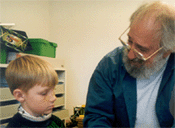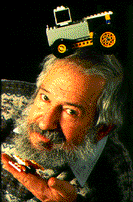Constructivist
Instruction
Theoretical
foundation
Dewey
Vygotsky
Piaget
Bruner
Contributions
of later work
Papert
CTGV
Gardner
Characteristics
Criticisms
|
Contributions of later work-Papert
of later work-Papert
Seymour Papert:
Turtles and Beyond
One of Piaget's
most famous American pupils, Seymour papert, has influenced profoundly
the field of educational technology. Papert began his career as
a mathematician. After studying with Jean Piaget in Geneva from
1959 to 1964, Papert became impressed with Piaget's way of "looking
at children as active builders of their own intellectual structures".
 Papert
subsequently joined the Artificial Intelligence Laboratory at the
Massachusetts Institute of Technology and began experimenting with
Logo, a new programming language, and its use with young children.
One of his colleagues was also working with children, teaching them
to control a robot in the shape of a turtle. The MIT team decided
to combine the two concepts, integrating an on-screen "turtle" and
the Logo language. This addition provided the vital link that papert
felt would allow children to move more easily from the concrete
operations of earlier stages of Piaget's hypothesis to more abstract
ones. In 1980, Papert published his theories in a book entitled
Mindstorms: Children, Computers, and Powerful ideas. This book challenged
then-current instructional goals and methods for both mathematics
and educational technology, and it became the first widely recognized
constructivist statement of educational practice with technology
resources. Papert
subsequently joined the Artificial Intelligence Laboratory at the
Massachusetts Institute of Technology and began experimenting with
Logo, a new programming language, and its use with young children.
One of his colleagues was also working with children, teaching them
to control a robot in the shape of a turtle. The MIT team decided
to combine the two concepts, integrating an on-screen "turtle" and
the Logo language. This addition provided the vital link that papert
felt would allow children to move more easily from the concrete
operations of earlier stages of Piaget's hypothesis to more abstract
ones. In 1980, Papert published his theories in a book entitled
Mindstorms: Children, Computers, and Powerful ideas. This book challenged
then-current instructional goals and methods for both mathematics
and educational technology, and it became the first widely recognized
constructivist statement of educational practice with technology
resources.
|
 of later work-Papert
of later work-Papert Papert
subsequently joined the Artificial Intelligence Laboratory at the
Massachusetts Institute of Technology and began experimenting with
Logo, a new programming language, and its use with young children.
One of his colleagues was also working with children, teaching them
to control a robot in the shape of a turtle. The MIT team decided
to combine the two concepts, integrating an on-screen "turtle" and
the Logo language. This addition provided the vital link that papert
felt would allow children to move more easily from the concrete
operations of earlier stages of Piaget's hypothesis to more abstract
ones. In 1980, Papert published his theories in a book entitled
Mindstorms: Children, Computers, and Powerful ideas. This book challenged
then-current instructional goals and methods for both mathematics
and educational technology, and it became the first widely recognized
constructivist statement of educational practice with technology
resources.
Papert
subsequently joined the Artificial Intelligence Laboratory at the
Massachusetts Institute of Technology and began experimenting with
Logo, a new programming language, and its use with young children.
One of his colleagues was also working with children, teaching them
to control a robot in the shape of a turtle. The MIT team decided
to combine the two concepts, integrating an on-screen "turtle" and
the Logo language. This addition provided the vital link that papert
felt would allow children to move more easily from the concrete
operations of earlier stages of Piaget's hypothesis to more abstract
ones. In 1980, Papert published his theories in a book entitled
Mindstorms: Children, Computers, and Powerful ideas. This book challenged
then-current instructional goals and methods for both mathematics
and educational technology, and it became the first widely recognized
constructivist statement of educational practice with technology
resources.